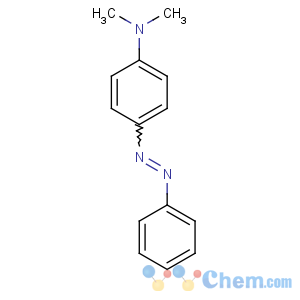Title: p-Dimethylaminoazobenzene
CAS Registry Number: 60-11-7
CAS Name: N,N-Dimethyl-4-(phenylazo)benzenamine
Synonyms: butter yellow; methyl yellow; C.I. Solvent Yellow 2; C.I. 11020
Molecular Formula: C14H15N3
Molecular Weight: 225.29
Percent Composition: C 74.64%, H 6.71%, N 18.65%
Literature References: Prepn:
Colour Index vol. 4 (3rd ed., 1971) p 4014. Review of carcinogenic risk:
IARC Monographs 8, 125-146 (1975).
Properties: Yellow cryst leaflets, mp 114-117°. Insol in water. Sol in alc, benzene, CHCl3, ether, petr ether, mineral acids, oils.
Melting point: mp 114-117°
CAUTION: Potential symptoms of overexposure are enlarged liver; hepatic and renal dysfunction; contact dermatitis; coughing, wheezing, difficulty breathing; bloody sputum; bronchial secretions; frequent urination, hematuria and dysuria.
See NIOSH Pocket Guide to Chemical Hazards (DHHS/NIOSH 97-140, 1997) p 110. This substance is reasonably anticipated to be a human carcinogen:
Report on Carcinogens, Eleventh Edition (PB2005-104914, 2004) p III-103.
Use: For determination of free HCl in gastric juice; spot test identification of peroxidized fats; pH indicator (red 2.9, yellow 4.0).

